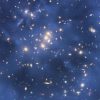What is dark matter?0
- From Around the Web, Science & Technology
- September 23, 2020
Peering into the dark.

Peering into the dark.

On a fine scale, the Universe seems lumpier than it should be.

Observations by the NASA/ESA Hubble Space Telescope and the European Southern Observatory’s Very Large Telescope (VLT) in Chile have found that something may be missing from the theories of how dark matter behaves. This missing ingredient may explain why researchers have uncovered an unexpected discrepancy between observations of the dark matter concentrations in a sample of massive galaxy clusters and theoretical computer simulations of how dark matter should be distributed in clusters. The new findings indicate that some small-scale concentrations of dark matter produce lensing effects that are 10 times stronger than expected.

Since the 1980s, researchers have been running experiments in search of particles that make up dark matter, an invisible substance that permeates our galaxy and universe. Coined dark matter because it gives off no light, this substance, which constitutes more than 80 percent of matter in our universe, has been shown repeatedly to influence ordinary matter through its gravity. Scientists know it is out there but do not know what it is.

A new study suggests that dark energy might not be real after all. But other scientists have found major flaws with this bold claim.

Astronomers are back in the dark about what dark matter might be, after new observations showed the mysterious substance may not be interacting with forces other than gravity after all. Dr Andrew Robertson of Durham University will today (Friday 6 April) present the new results at the European Week of Astronomy and Space Science in Liverpool.

Getting rid of dark matter would be a big ordeal, so we talk to the man behind the theory.

A small but distinctive signal in X-rays from the Milky Way could be key to proving the existence of dark matter.

Astronomers in the US are setting up an experiment which, if it fails – as others have – could mark the end of a 30-year-old theory



